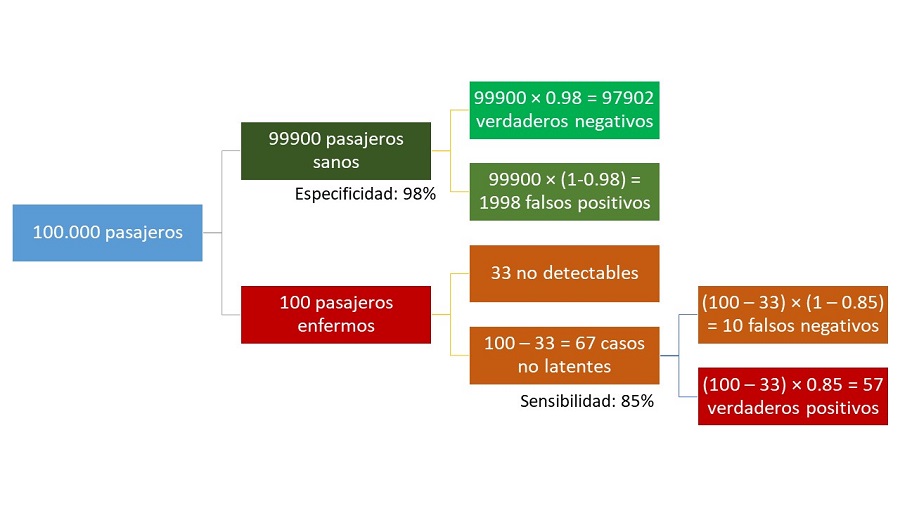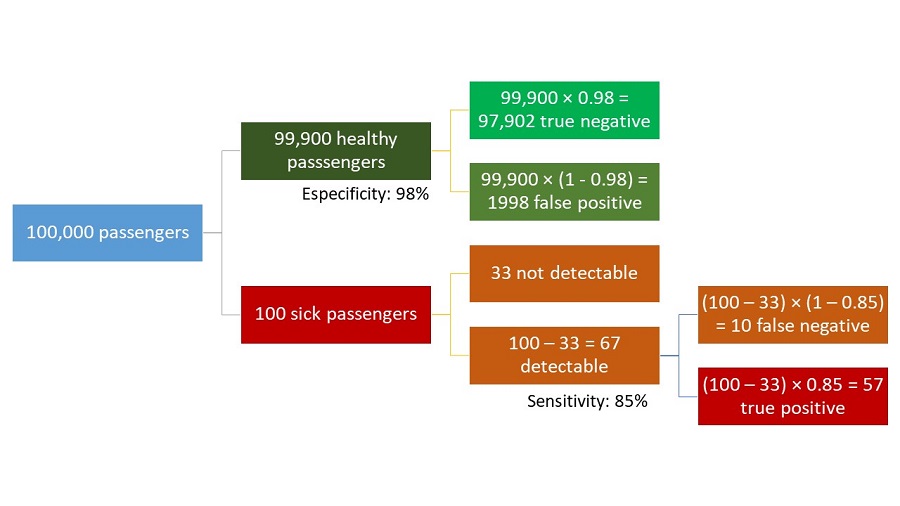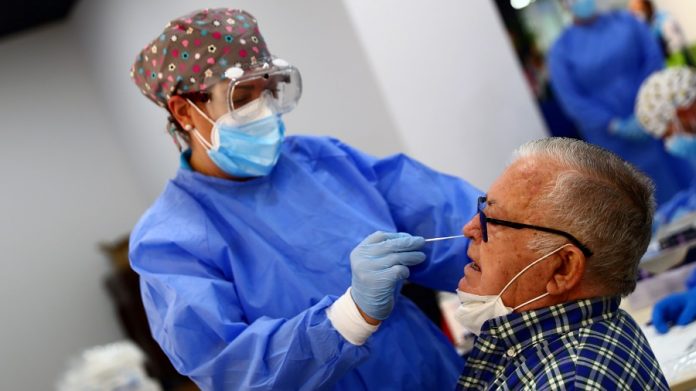La comunidad científica ha debatido con exhaustividad la necesidad y relevancia de los test masivos sin encontrar ninguna utilidad. Pero parece que la clase regente está empeñada en llevarlos a cabo una y otra vez. A pesar de ser biólogo, cosas como una epidemia vírica del calibre de la que estamos sufriendo quedan lejos de mi completo entendimiento. Pero sé que los tests masivos no sirven para nada, porque sí sé algo de matemáticas. Si sabe usted multiplicar, seguramente sabe lo suficiente como para entender que, como veremos en esta información, los test masivos de covid-19 no tienen sentido.

Sevilla.-
No, no fue a la cárcel. Y aquel que colocó una barca en una carreta e hizo el informe como si todo estuviera cubierto de agua porque él iba en barca, ese tampoco fue a la cárcel. Y los que sobornaron a los congresistas y legisladores tampoco fueron nunca a la cárcel. (Las uvas de la ira. John Steinbeck).
Una lectura rápida a las noticias del día muestra que nuestros dirigentes vuelven a la idea de los test masivos de covid-19. Leo alarmado sobre las ideas de realizar test masivos en aeropuertos o en ciudades como Madrid, Sevilla, Barcelona…
La comunidad científica ha debatido con exhaustividad la necesidad y relevancia de los test masivos sin encontrar ninguna utilidad. Pero parece que la clase regente está empeñada en llevarlos a cabo una y otra vez. En mi opinión, esto es solo para tranquilizar a la población y ocultar su propia incapacidad. A pesar de ser biólogo, cosas como una epidemia vírica del calibre de la que estamos sufriendo quedan lejos de mi completo entendimiento. Pero sé que los tests masivos no sirven para nada, porque sí sé algo de matemáticas. Si sabe usted multiplicar, seguramente sabe lo suficiente como para entender que, como veremos a continuación, los test masivos de covid-19 no tienen sentido.
Esto es solo para tranquilizar a la población y ocultar la propia incapacidad de los gobernantes.
Ningún test de covid-19 es infalible. Pero, al mismo tiempo, estos tests son útiles porque los científicos conocen cómo de grande es esta infalibilidad. Entre otros muchos, hay dos parámetros asociados a lo que podríamos llamar la “eficacia” de un test como la PCR o los de antígenos: la sensibilidad y la especificidad. La “sensibilidad” es la capacidad del test para detectar los pacientes enfermos (es decir, un test de covid-19 es “sensible” si es capaz de detectar pacientes enfermos de covid-19). Por otro lado, la “especificidad” es la capacidad del test para detectar a los pacientes sanos (es decir, un test de covid-19 es “específico” si no confunde a un paciente sano o a un paciente de gripe con uno de covid-19).
Es decir, que un test de covid-19 (como cualquier otro test de cualquier cosa) no nos da simplemente casos positivos y casos negativos. Un test puede arrojar “verdaderos positivos” (personas enfermas detectadas como enfermas), “verdaderos negativos” (personas sanas detectadas como sanas), “falsos positivos” (personas sanas detectadas erróneamente como enfermas) y “falsos negativos” (personas enfermas detectadas erróneamente como sanas).
SENTIDO Y SENSIBILIDAD
Podemos definir entonces la sensibilidad de un test como el número de verdaderos positivos dividido entre la suma de verdaderos positivos y falsos negativos. El número resultante nos daría la probabilidad de un test de que el paciente detectado como positivo (enfermo) esté, efectivamente, enfermo.
Son tests de diagnóstico, que son muy eficaces solo si la persona presenta síntomas.
Del mismo modo, la especificidad podría estimarse como el número de verdaderos negativos dividido entre la suma de verdaderos negativos y falsos positivos. Es decir, la probabilidad de que una persona detectada como caso negativo (sana) esté, efectivamente, sana.
Es obvio que si un test tiene una baja sensibilidad y/o una baja especificidad, no sirve de nada. Así que los tests utilizados tienen valores muy altos de ambos parámetros. En general, y variando poco los números según el estudio que se consulte, podemos decir que un test de PCR tiene una sensibilidad en torno al 85% y una especificidad en torno al 98%. Esto son números muy altos. El test PCR parece fiable.
Ahora supongamos que varios aviones cargados de, digamos, franceses aterrizan en, digamos, Madrid. Supongamos que la prevalencia de la infección es que uno de cada mil está infectado de covid-19. No tengo ni idea de la prevalencia de la infección entre los franceses ahora mismo, es solo un ejemplo, pero es un valor aproximado a la realidad.
Como decía, supongamos que llegan a Madrid unos 100.000 franceses y les hacemos un test PCR a la llegada (no tengo ni idea de cuántos llegan al día, es un ejemplo con números sencillos para facilitarle los cálculos a usted). Si la prevalencia de la infección es del uno por mil, tendríamos a 99.900 pasajeros sanos y 100 infectados por covid-19. A todo esto, aproximadamente un tercio de esos 100 pasajeros enfermos, estarán en los primeros días de la infección, cuando no presentan síntomas y la carga viral es tan baja que es prácticamente imposible de detectar. De este modo, después del test PCR (sensibilidad del 85% y especificidad del 98%), entre los 99.900 pasajeros sanos habremos detectado 97.902 verdaderos negativos (sanos como peras) y 1.998 falsos positivos (sanos como peras que creemos que están enfermos).
A la vez, de los 100 enfermos, 33 tienen una carga viral baja no detectados, otros 10 falsos negativos (infectados que no detectamos), y 57 verdaderos positivos (o sea, señores infectados que hemos detectado correctamente.
¿De dónde vienen estos números? Veámoslo con un gráfico.

De este modo, estamos dejando pasar un 43% de personas enfermas que no hemos sido capaces de detectar. Ojo, y estamos confinando innecesariamente a 1.998 falsos positivos (personas sanas).
Los tests de antígenos se mueven aproximadamente en los mismos parámetros de sensibilidad y especificidad. Entonces, si ambos tipos de test son un coladero, ¿por qué los usan los médicos? Porque son tests de diagnóstico. Son muy eficaces si la persona presenta síntomas. Si el paciente presenta síntomas de covid-19 la carga viral sí es alta y el test ayuda a rechazar o aceptar el diagnóstico con mucha seguridad. A pesar de todo, la seguridad nunca es del 100% y todos aquellos que se hayan hecho un test tras un contacto de riesgo habrán leído en su informe, incluso si es negativo, la recomendación de guardar cuarentena. Pero, como vemos, un cribado masivo en una ciudad, en un aeropuerto, en los toros o en un concierto no tiene ningún motivo ni es garantía de nada.
¿Qué es lo que hay que hacer? Pues hacer caso a las recomendaciones y usar el sentido común. No mezclarse con multitudes, no permanecer en interiores poco ventilados, no viajar en tren, autobús o avión si no es imprescindible, usar la mascarilla, lavarse las manos y ser prudente. Si alguien le ofrece un test gratuito sin presentar síntomas es que quiere su voto o su dinero y no está preocupado en absoluto por su salud.
Como dice don Federico Nietzsche acerca de las personas que se creen dueñas de la verdad: “les basta encontrar sobre un asunto una hipótesis cualquiera, en seguida se enardecen con ella y creen que ya está dicho todo. Tener una opinión científica significa, por eso mismo, en ellos: convertirse en seguida en un fanático y, finalmente tomarla a pecho como una convicción. Se enardecen, a propósito de una cosa explicada, con la primera fantasía que les pasa por la mente y que se parezca a una explicación, de donde resultan continuamente, sobre todo en el dominio de la política, las consecuencias más enojosas” (Humano, demasiado humano. Friedrich Nietzsche).
VERSIÓN INGLESA
MASSIVE COVID-19 TEST ARE USELESS, MATHEMATICS PROVES IT
No, he never went to jail for it. An’ the fella that put a boat in a wagon an’ made his report like it was all under water ‘cause he went in a boat he never went to jail neither. An’ the fellas that bribed congressmen and the legislatures never went to jail neither.( The grapes of wrath. John Steinbeck).
A quick read of newspapers shows that our leaders are back to the idea of massive tests for covid-19. I am scared after reading about conducting massive tests at airports or in cities such as Madrid, Seville, Barcelona …
The scientific community has extensively debated the need and relevance of mass testing without finding any use. But it seems that the ruling class is hell-bent on carrying them out over and over again. From my point of view, this is only to reassure the population and hide their own incapacity. Despite being a biologist, a viral pandemic such us that we are suffering from are far from my area of expertise. But I know that mass tests are useless, because I do know some maths. If you know how to multiply, you surely know enough to understand that, as we will see below, mass covid-19 tests do not make sense.
No covid-19 test is foolproof. But at the same time, these tests are useful because scientists know how small their infallibility is. Among many others, there are two parameters associated with what we could call the «efficiency» of a proof such as PCR or antigen tests: sensitivity and specificity. «Sensitivity» of a test is its ability to detect sick patients (that is, a COVID-19 test is «sensitive» if it is able to detect sick COVID-19 patients). On the other hand, “specificity” of a test is its ability to detect healthy patients (that is, a COVID-19 test is “specific” if it does not confuse a healthy patient or a flu patient with a COVID-19 patient).
That is, a covid-19 test (like any other test for anything) does not simply give us positive cases and negative cases. A test can yield “true positives” (sick people detected as sick), “true negatives” (healthy people detected as healthy), “false positives” (healthy people wrongly detected as sick) and “false negatives” (sick people wrongly detected as healthy).
We can then define the sensitivity of a test as the number of true positives divided by the sum of true positives and false negatives. The resulting number would give us the probability of a test that the patient detected as positive (sick) is, indeed, sick.
Similarly, specificity could be estimated as the number of true negatives divided by the sum of true negatives and false positives. That is, the probability that a person detected as a negative case (healthy) is actually healthy.
It is obvious that if a test has a low sensitivity and / or a low specificity, it is of no use. So the tests used have very high values of both parameters. Generally, with numbers varying little depending on the study, we can say that a PCR test has a sensitivity of around 85% and a specificity of around 98%. These are very high numbers. The PCR test seems reliable.
Now suppose that several airplanes loaded with, say, French land in, say, Madrid. Suppose the prevalence of infection is one in a thousand (0.1% is infected with covid-19). I have no idea the prevalence of the infection among French people right now, it is just an example, but it is an approximate value to reality.
O, let’s go. Suppose 100,000 French arrive in Madrid and we do a PCR test on arrival (I have no idea how many frenchies arrive per day, it is an example with simple numbers to facilitate the calculations for you). If the prevalence of the infection is one per thousand, we should have 99,900 healthy passengers and 100 infected by covid-19. To all this, approximately a third of those 100 sick passengers will be in the first days of the infection, when they do not show symptoms and the viral load is so low that it is practically impossible to detect. Thus, after the PCR test (remember, sensitivity of 85% and specificity of 98%), among the 99,900 healthy passengers we will have detected 97,902 true negatives (healthy as a horse) and 1998 false positives (healthy as a horse, but we think they are sick).
At the same time, of the 100 patients, 33 have an undetected low viral load, 10 false negatives (infected but not detect), and 57 true positives (that is, infected and correctly detected).
Where do these numbers come from? Let’s see it with a graph.
 So, we are letting 43% of sick people pass that we have not been able to detect. Be careful, and we are unnecessarily confining to 1998 false positives (healthy people).
So, we are letting 43% of sick people pass that we have not been able to detect. Be careful, and we are unnecessarily confining to 1998 false positives (healthy people).
Antigen tests run roughly the same parameters of sensitivity and specificity. So if both types of tests are an easy way in, why do doctors use them? Because they are diagnostic tests. They are very effective if the patient has symptoms. If the patient presents symptoms of covid-19, the viral load is high and the test helps to reject or accept the diagnosis with great confidence. Despite everything, security is never 100% and all those who have taken a test after a risk contact will have read in their report, even if it is negative, the recommendation to keep quarantine. But, as we see, a massive screening in a city, in an airport, in bullfighting (we still have bullfight in Spain, come and see the Neanderthals) or in a concert has no reason and is not a guarantee of anything.
What to do? Well, listen to the recommendations and use common sense. Do not mix with crowds, do not stay in poorly ventilated indoor areas, do not travel by train, bus or plane if not essential, wear a mask, wash your hands and be careful. If someone offers you a free test without showing symptoms, they want your vote or your money and are not concerned about your health at all.
As Mr. Nietzsche says about people who believe they are owners of the truth: “it is enough for them to find any kind of hypothesis on a subject, they are then all on fire for it, and imagine the matter is thereby settled. To have an opinion is with them equivalent to immedi- ately becoming fanatical for it, and finally taking it to heart as a conviction. In the case of an unexplained matter they become heated for the first idea that comes into their head which has any resemblance to an explanation—a course from which the worst results constantly follow, especially in the field of politics” (Human, all too human. Friedrich Nietzsche).
(Antonio Jordán López es un destacado científico español, doctor en Biología y profesor de Ciencias del Suelo de la Universidad de Sevilla, con una amplia labor investigadora y obra publicada).
SOBRE EL AUTOR
El destacado científico Antonio Jordán López, nuevo colaborador de PROPRONews


